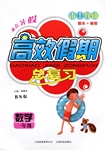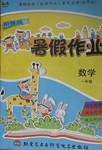
He was walking along the sands ______ he saw a big footprint in the sand.
| A.while | B.as | C.when | D.after |
 暑假作业海燕出版社系列答案
暑假作业海燕出版社系列答案 本土教辅赢在暑假高效假期总复习云南科技出版社系列答案
本土教辅赢在暑假高效假期总复习云南科技出版社系列答案 暑假作业北京艺术与科学电子出版社系列答案
暑假作业北京艺术与科学电子出版社系列答案科目:高中英语 来源: 题型:阅读理解
The Wal-Mart in Cleburne, Texas, was crowded. People were waiting in long lines at checkout counters to pay for small things that would be next-morning treasures under someone’s Christmas tree.
The woman standing in cashier Jeffrey Kandt’s line seemed to be living on the edge of subsistence(生计). Her clothes were worn and her hands were those of a person who’d worked hard for what she had. She held a single item in her arms as she patiently waited to move to the front of the line — a Sony CD player. She had saved all year for this. With tax, the total would be close to $ 220.
As the woman got close to the cashier, she suddenly shouted, “Where’s my money? All of my money fro my son’s gift! Oh no!”
“Why my line?” Kandt thought as he watched the poor woman searching through her clothes. He was going to have to call his manager to avoid the sale but it would mean a long wait for the customers behind her. “I am going to go home late tonight,” Kandt thought.
Then an amazing thing happened. At the back of the line, a man took out his wallet, pulled out $100 and passed it forward. As the cash moved up the line, a twen5ty-dollar bill was added here, and a ten-dollar bill was added there. When the collection finally reached the registewr, Kandt counted $ 220.
Strangers had fulfilled a poor woman’s Christmas wish.
The poor in his line at the Wal-Mart in Cleburne, Texas, had come together on Christmas Eve, 2002.
According to the passage, the woman’s Christmas wish was to ______.
A.collect $ 220 for her family B.buy her son a CD player as a gift
C.buy enough food for her family D.organize a big party for her son
Which of the following statements is TRUE about Jeffrey Kandt when the woman couldn’t find her money?
A.He was impatient and wanted to go home.
B.He wanted to see whether the woman had money or not.
C.He wanted the woman to stand in another line.
D.He didn’t think about the customers waiting behind the woman.
What does paragraph 5 mainly talk about?
A.a description of a man standing in the line
B.the cashier, Jeffery Kandt
C.the collection of $ 220
D.a reason why the strangers collected he money
What can we learn from the passage?
A.The woman collected money by herself.
B.The woman seemed to be poor, but in fact had lots of money.
C.Strangers in the line volunteered to help the woman.
D.The woman had never ay money.
查看答案和解析>>
科目:高中英语 来源:同步题 题型:阅读理解
 mes, such as drunk driving and theft.
mes, such as drunk driving and theft. thief put here by
thief put here by 查看答案和解析>>
科目:高中英语 来源: 题型:阅读理解
Sam Walton, the founder of Wal-Mart, was born in Kingfish, Oklahoma on March 29, 1918. He was raised in Missouri where he worked in his father’s store while attending school. This was his first retailing (零售业) experience and he really enjoyed it. After graduation, he began his own career as a retail merchant.
He soon opened his first Wal-Mart store in 1962 in Rogers, Arkansas. Wal-Mart specialized in name brands at low prices and Sam Walton was surprised at the success. Soon a chain of Wal-Mart stores sprang up across rural America.
Walton's management style was popular with employees and he founded some of the basic concepts (概念) of management that are still in use today.
After taking the company public in 1970, Walton introduced his “profit sharing plan”. The profit sharing plan was a plan for Wal-Mart employees to improve their income dependent on the profits of the store. Sam Walton believed that “individuals don't win, teams do”. Employees at Wal-Mart stores were offered stock options (认股权) and store discounts. These benefits are commonplace today, but Walton was among the first to implement (实现) them. Walton believed that a happy employee meant happy customers and more sales. He also believed that by giving employees a part of the company and making their success dependent on the company’s success, they would care about the company.


growing complaints that the “superstore” was stopping smaller and traditional stores from developing. By 1991, Wal-Mart was the largest US retailer with 1,700 stores. Walton remained active in managing the company, as president and CEO until 1988 and chairman until his death. He was awarded the Medal of Freedom shortly before his death.
56. Sam Walton first made a hit in retailing when __________.
A. he worked in his father’s store
B. he created Walton's management style
C. he specialized in name brands at low prices
D. a chain of Wal-Mart stores sprang up across rural America
57. Walton’s management style emphasized __________ very much.
A. individual efforts B. team spirit C. employees' loyalty D. fair distribution
58. What is the purpose of Walton’s carrying out “profit sharing plan”?
A. To encourage the employees to work hard and make joint efforts.
B. To make sure all the employees had their own shares.
C. To select excellent employees for his stores.
D. To make more profit for himself.
59. Which of the statements is TRUE?
A. In his old age, Walton gave all the management to his men.
B. Walton wasn’t one of the merchants who first implemented stock options.
C. The smaller and traditional stores were well affected by Walton’s stores.
D. With Walton’s management style, employees treated the stores as their own.
60. What does the underlined word “edge” in the last paragraph mean here?
A. Advantage. B. Disadvantage. C. Danger. D. System.
查看答案和解析>>
科目:高中英语 来源: 题型:阅读理解
Sam Walton, the founder of Wal-Mart, was born in Kingfish, Oklahoma on March 29, 1918. He was raised in Missouri where he worked in his father’s store while attending school. This was his first retailing (零售业) experience and he really enjoyed it. After graduation, he began his own career as a retail merchant.
He soon opened his first Wal-Mart store in 1962 in Rogers, Arkansas. Wal-Mart specialized in name brands at low prices and Sam Walton was surprised at the success. Soon a chain of Wal-Mart stores sprang up across rural America.
Walton's management style was popular with employees and he founded some of the basic concepts of management that are still in use today.
After taking the company public in 1970, Walton introduced his “profit sharing plan”. The profit sharing plan was a plan for Wal-Mart employees to improve their income dependent on the profits of the store. Sam Walton believed that “individuals don't win, teams do”. Employees at Wal-Mart stores were offered stock options (认股权) and store discounts. These benefits are commonplace today, but Walton was among the first to implement (实现) them. Walton believed that a happy employee meant happy customers and more sales. He also believed that by giving employees a part of the company and making their success dependent on the company’s success, they would care about the company.
By the 1980s, Wal-Mart had sales of over one billion dollars and over three hundred stores across North America. Wal-Mart’s unique decentralized (分散的) distribution system, also Walton’s idea, created the edge needed to further encourage growth in the 1980s during growing complaints that the “superstore” was stopping smaller and traditional stores from developing. By 1991, Wal-Mart was the largest US retailer with 1,700 stores. Walton remained active in managing the company, as president and CEO until 1988 and chairman until his death. He was awarded the Medal of Freedom shortly before his death.
56. Sam Walton first made a hit in retailing when __________.
A. he worked in his father’s store
B. he created Walton's management style
C. a chain of Wal-Mart stores sprang up across rural America
D. he specialized in name brands at low prices
57. What is the purpose of Walton’s carrying out “profit sharing plan”?
A. To make sure all the employees had their own shares.
B. To encourage the employees to work hard and make joint efforts.
C. To select excellent employees for his stores.
D. To make more profit for himself.
58. Which of the statements is TRUE?
A. With Walton’s management style, employees treated the stores as their own.
B. Walton wasn’t one of the merchants who first implemented stock options.
C. The smaller and traditional stores were well affected by Walton’s stores.
D. In his old age, Walton gave all the management to his men.
59. What does the underlined word “edge” in the last paragraph mean here?
A. Danger. B. Disadvantage. C. Advantage. D. System.
查看答案和解析>>
科目:高中英语 来源: 题型:阅读理解
Sam Walton, the founder of Wal-Mart, was born in Kingfish, Oklahoma on March 29, 1918. He was raised in Missouri where he worked in his father’s store while attending school. This was his first retailing (零售业) experience and he really enjoyed it. After graduation, he began his own career as a retail merchant.
He soon opened his first Wal-Mart store in 1962 in Rogers, Arkansas. Wal-Mart specialized in name brands at low prices and Sam Walton was surprised at the success. Soon a chain of Wal-Mart stores sprang up across rural America.
Walton's management style was popular with employees and he founded some of the basic concepts of management that are still in use today.
After taking the company public in 1970, Walton introduced his “profit sharing plan”. The profit sharing plan was a plan for Wal-Mart employees to improve their income dependent on the profits of the store. Sam Walton believed that “individuals don't win, teams do”. Employees at Wal-Mart stores were offered stock options (认股权) and store discounts. These benefits are commonplace today, but Walton was among the first to implement (实现) them. Walton believed that a happy employee meant happy customers and more sales. He also believed that by giving employees a part of the company and making their success dependent on the company’s success, they would care about the company.
By the 1980s, Wal-Mart had sales of over one billion dollars and over three hundred stores across North America. Wal-Mart’s unique decentralized (分散的) distribution system, also Walton’s idea, created the edge needed to further encourage growth in the 1980s during growing complaints that the “superstore” was stopping smaller and traditional stores from developing. By 1991, Wal-Mart was the largest US retailer with 1,700 stores. Walton remained active in managing the company, as president and CEO until 1988 and chairman until his death. He was awarded the Medal of Freedom shortly before his death.
56. Sam Walton first made a hit in retailing when __________.
A. he worked in his father’s store
B. he created Walton's management style
C. a chain of Wal-Mart stores sprang up across rural America
D. he specialized in name brands at low prices
57. What is the purpose of Walton’s carrying out “profit sharing plan”?
A. To make sure all the employees had their own shares.
B. To encourage the employees to work hard and make joint efforts.
C. To select excellent employees for his stores.
D. To make more profit for himself.
58. Which of the statements is TRUE?
A. With Walton’s management style, employees treated the stores as their own.
B. Walton wasn’t one of the merchants who first implemented stock options.
C. The smaller and traditional stores were well affected by Walton’s stores.
D. In his old age, Walton gave all the management to his men.
59. What does the underlined word “edge” in the last paragraph mean here?
A. Danger. B. Disadvantage. C. Advantage. D. System.
查看答案和解析>>
湖北省互联网违法和不良信息举报平台 | 网上有害信息举报专区 | 电信诈骗举报专区 | 涉历史虚无主义有害信息举报专区 | 涉企侵权举报专区
违法和不良信息举报电话:027-86699610 举报邮箱:58377363@163.com